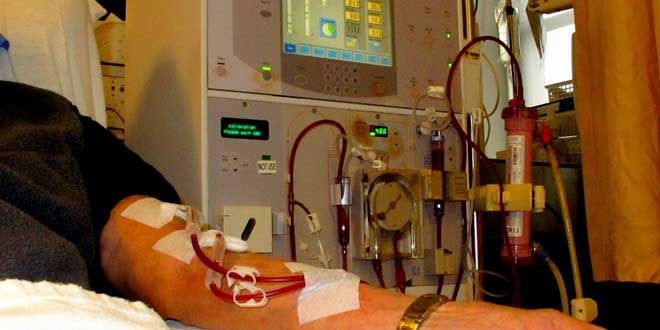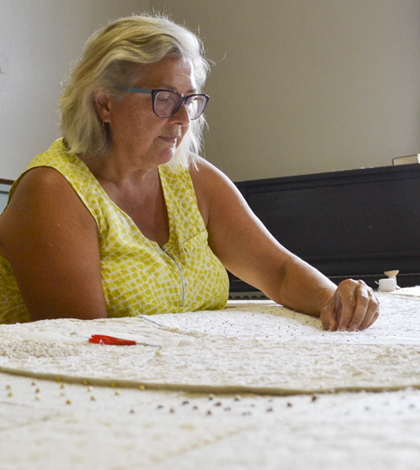WIKWEMIKONG—Wikwemikong Chief Duke Peltier believes his community should house a diabetic centre for excellence, starting with its own dialysis unit, and so began discussions on the subject with the Ontario Renal Network (ORN) late last year.
The chief noted in an interview with The Expositor from his community that there are currently five patients requiring hemodialysis treatment in Little Current. (This number has been reduced from 10 over the past year due to deaths.) These treatments are usually required at least three times a week with duration of approximately four hours per treatment—an arduous process.
As he has in past conversations with The Expositor regarding the health needs of his community, Chief Peltier pointed to the much smaller municipality of Assiginack, Wikwemikong’s neighbours, and its Family Health Team complete with doctor and staff. His community, he reminded, is the largest on Manitoulin but does not have a full-time doctor. (Wikwemikong accesses physicians through an arrangement with the Little Current medical clinic.)
A November meeting with the ORN included Dr. David Berry, the regional lead for the network, where he was tasked to look at the challenges faced by the people of Wikwemikong, the chief explained. Among them, amputations performed on people younger than 50 due to complications from diabetes, and death.
The chief noted the startling statistics that show between 30 and 60 percent of First Nations people will develop kidney disease and that 15 to 30 percent of this population will develop stage four kidney disease, meaning dialysis.
The ORN recommended a health centre-focussed model be switched to a prevention-based model, the chief said, implemented by a community-wide education campaign.
“We do this already, but we will keep doing it,” he said. “Many patients don’t get the chance to see a doctor prior to the onset of full-blown diabetes. There are warning signs that come with it, so it can be reversed, or managed, but oftentimes when adults in the community want to see a doctor, they want to see him/her right away, but instead they will have to wait for between two and six months to get an appointment. And a trip to the emergency room is not the answer either.”
Dr. Berry, who stepped into the role of Northeast region lead in September, said the conversation began when Wikwemikong brought forward to the ORN a request for getting a dialysis unit in the community. Patients requiring dialysis currently fall under the umbrella of Health Sciences North (HSN), with the service accessed at the Manitoulin Health Centre in Little Current, with roughly five people who travel numerous times each week.
“The discussion began to centre around the path of a patient with chronic kidney disease, which is a huge problem within the First Nation community,” Dr. Berry told The Expositor in a telephone interview. “The risk for First Nations people can range anywhere from 12 to 50 percent, depending on age. Complications from chronic kidney disease are also higher,” he added.
Dr. Berry said it became rapidly apparent that there were gaps in providing renal care to the community, not just in the form of dialysis.
“The number of referrals (to HSN) were far smaller compared to what should be seen for a community of that size,” he said. “Either this community is very different from what we normally see, or for whatever reason patients are not accessing the health care they need, and my suspicion is the latter.” This, he said, changed the direction of the conversation.
Studies show that 59.1 out of every 1,000 people have chronic kidney disease—in Wikwemikong’s case this would translate to 180 people out of 3,000, yet HSN has only four people in its records from that community. “And the number of people needing dialysis is usually bang on when looking at statistics,” the doctor said.
The “lions share” of people with chronic kidney disease have stage three kidney disease, the doctor explained, which means they only have 30 to 60 percent kidney function. And with proper health care, “you can potentially reduce or prevent the need for dialysis,” Dr. Berry said.
The pre-dialysis group, he continued, will also greatly benefit from a higher level of care so that as their disease progresses, the transition will be a smooth one, requiring little hospital time as they become accustomed to hemodialysis, should they get to that stage.
“The less impact on a patient’s life, the better,” he said.
One disconcerting statistic regarding First Nations patients with kidney disease is that while the rate of the disease is higher, the number of people on dialysis is lower. This may be, the doctor said, because of higher rates of mortality.
“There is a significant potential for a kidney disease strategy that might benefit hundreds of people, and not just five or six,” Dr. Berry continued.
To host a dialysis unit is a huge undertaking, he explained, when the amount of clean water (each patient will require 96 litres of the purest of water at least three times a week), infrastructure, staffing and maintenance is factored in.
To start an education campaign and target community members who are in need of health care before it’s too late would mean a cost savings to the community, with a much higher yield, Dr. Berry shared.
“My main concern is that the community isn’t being missed in its quest for a dialysis unit,” he added.
Since their last meeting in November, Wikwemikong and the ORN and Dr. Berry are working to see what resources are available currently with the first goal to develop educational materials with a focus on First Nations renal health. Dr. Berry envisions this as a four step process: prevent progression and complications; a focus on the quality and quantity of life; increase the visibility of care for those at risk; and gradually building the local expertise that could, one day if necessary, support a dialysis unit.
Dr. Berry reiterated his thoughts that a dialysis unit should not be the first step on this journey. “There are these few people that are very obviously needing dialysis; they’re the tip of the iceberg, but there are hundreds of people needing chronic kidney disease care, and they’re the people that will sink your ship,” he concluded.
Chief Peltier still hopes to see his community step up to the plate in the constant battle against chronic kidney disease and diabetes with the goal of a centre of excellence in his sights. “Between the Renal Network, Health Sciences North and the Ministry of Health, I think we can come up with a viable solution to meet the health care needs of everyone,” the chief said.





